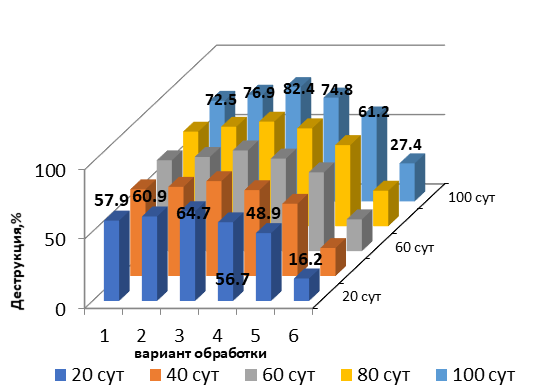INFLUENCE OF THE MODIFIED WOOD BARK "UNISORB-BIO" ON THE RESTORATION OF SOILS CONTAMI-NATED WITH OIL
UDC 579.66
Abstract
The article examines the effect of the "Unisorb-Bio" carbamide sorbent modified with wood bark on the biodegradation of fuel oil using the example of artificially contaminated soil.
It is shown that for 100 days of exposure "Unisorb-Bio" and actinomycetes immobilized on it (Streptomyces exfoliatus strain) are able to effectively decompose fuel oil. The maximum value of the degree of destruction of fuel oil was 82.7% in soil samples with a sorbent modified with birch bark. In the samples with larch bark, this figure is 7.3% lower. The degree of destruction of fuel oil in the control soil sample (soil with fuel oil) for the entire exposure period was – 27.4%. If this figure is taken as the background, then only the direct contribution to the degradation of fuel oil biosorbent is 45.1%; biosorbent with 0.2% diammofoska – 55%; sorbent without microorganisms – 33.8%.
The results showed that the used carbamide sorbent with immobilized and native microflora is capable of effectively decomposing fuel oil to concentrations that allow the transition to agrotechnical measures. Thus, sowing watercress on soils after the end of the experiment showed that seed germination is 50–60%, which suggests that residual concentrations of fuel oil are relatively harmless to the root system of plants and the completion of the bioremidation process can be carried out by growing plants that are resistant to residual concentrations of pollutants.
In general, the result confirms the effectiveness of the applied method in accelerating bioremidation processes, but further development is required in the direction of creating mixed associations of UVOM.
Downloads
Metrics
References
Vosstanovleniye neftezagryaznennykh pochvennykh ekosistem. [Restoration of oil-contaminated soil ecosystems]. Mos-cow, 1988, 254 p. (in Russ.).
Degradatsiya i okhrana pochv [Degradation and protection of soils], ed. G.V. Dobrovol'sky. Moscow, 2002, 654 p. (in Russ.).
Zvolinskiy V.P., Batovskaya Ye.K., Chernykh N.A. Agrokhimicheskiy vestnik, 2005, no. 2, pp. 22–25. (in Russ.).
Korshunova T.Yu., Chetverikov S.P., Bakayeva M.D., Kuzina Ye.V., Rafikova G.F., Chetverikova D.V., Logi-nov O.N. Prikladnaya biokhimiya i mikrobiologiya, 2019, vol. 55, no. 4, pp. 338–349. DOI: 10.1134/S0555109919040093 (in Russ.).
Loginov O.N., Silishchev N.N., Boyko T.F., Galimzyanova N.F. Biotekhnologicheskiye metody ochistki okruzhayu-shchey sredy ot tekhnogennykh zagryazneniy. [Biotechnological methods of cleaning the environment from technogenic pollution]. Ufa, 2000, 100 p. (in Russ.).
Abrosimov A.A. Ekologiya pererabotki uglevodorodnykh sistem. [Ecology of processing of hydrocarbon systems]. Moscow, 2002, p. 30. (in Russ.).
Dyadechko V.N. Pochvovedeniye, 1990, no. 9, pp. 148–154. (in Russ.).
Ismaylov N.I., Pikovskiy Yu.I. Vosstanovleniye neftezagryaznennykh pochvennykh ekosistem. [Restoration of oil-contaminated soil ecosystems]. Moscow, 1988, pp. 222–236. (in Russ.).
Koronelli T.V. Prikladnaya biokhimiya i mikrobiologiya, 1996, vol. 32, no. 6, pp. 579–585. (in Russ.).
Fedorova O.S., Ryazanova T.V., Kiriyenko I.A. Vestnik KrasGAU, 2009, no. 5, pp. 81–85. (in Russ.).
Ryazanova T.V., Fedorova O.S., Loskutov S.R. J. Sib. Fed. Univ. Chem., 2018, vol. 11(2), pp. 184–196. DOI: 10.17516/1998-2836-0067.
Petrov A.A. Uglevodorody nefti. [Petroleum hydrocarbons]. Moscow, 1984, 260 p. (in Russ.).
Tumanyan A.F., Batovskaya Ye.K. Tekhnologiya nefti i gaza, 2009, no. 6 (65), pp. 8–12. (in Russ.).
Sovremennaya mikrobiologiya. Prokarioty: V 2-kh tomakh [Modern microbiology. Prokaryotes: In 2 volumes], ed. Y. Lengelera, G. Drevsa, G. Shlegelya. Moscow, 2005, vol. 1, 656 p. (in Russ.).
Chukov S.N., Lodygin Ye.D., Gabov D.N., Beznosikov V.A. Vestnik SPbGU, 2006, no. 1, pp. 119–129. (in Russ.).
Ravinskiy F.YA., Afanas'yev M.I., Teplitskaya T.A., Alekseyeva T.A. Monitoring fonovogo zagryazneniya prirodnykh sred, 1990, no. 6, pp. 3–14. (in Russ.).
Tikhonova T.A. Sbornik statey studentov, aspirantov i molodykh uchenykh po itogam Vserossiyskoy nauchno-prakticheskoy konferentsii (s mezhdunarodnym uchastiyem). [Collection of articles by students, graduate students and young scientists following the results of the All-Russian scientific-practical conference (with international participa-tion)]. Krasnoyarsk, 2012, vol. 1, 286 p. (in Russ.).
Volchenko N.N., Karasova E.V. Biotekhnologiya, 2006, no.2, pp. 45–60. (in Russ.).
Volchenko T.I. Karasova E.V. Biotekhnologiya, 2008, no. 6, pp. 57–62. (in Russ.).
Gafarov A.B. Biotekhnologiya, 2008, no. 6, pp. 80–85. (in Russ.).
Nazarov A.V., Ilarionov S.A. Biotekhnologiya, 2007, no. 3, pp. 56–64. (in Russ.).
Ryazanova T.V., Fedorova O.S., Marchenko R.A., Shurkina V.I. Novyye dostizheniya v khimii i khimicheskoy tekhnologii rastitel'nogo syr'ya. [New achievements in the chemistry and chemical technology of plant raw materials]. Barnaul, 2017, pp. 327–329. (in Russ.).
PND F 16.1.41-04. Kolichestvennyy khimicheskiy analiz pochv. Metodika vypolneniya iz-mereniy massovoy kontsen-tratsii nefteproduktov v probakh pochv gravimetricheskim metodom. [PND F 16.1.41-04. Quantitative chemical analy-sis of soils. Methods of measuring the mass concentration of oil products in soil samples by the gravimetric method]. (in Russ.).
Belovezhets L.A., Makarova L.Ye., Tret'yakova M.S., Markova Yu.A., Dudareva L.V. Prikladnaya biokhimiya i mikrobiologiya, 2017, vol. 53, no. 1, pp. 76–81. (in Russ.).

Copyright (c) 2020 chemistry of plant raw material

This work is licensed under a Creative Commons Attribution 4.0 International License.

This work is licensed under a Creative Commons Attribution 4.0 International License.
The authors, which are published in this journal, agree to the following conditions:
1. Authors retain the copyright to the work and transfer to the journal the right of the first publication along with the work, at the same time licensing it under the terms of the Creative Commons Attribution License, which allows others to distribute this work with the obligatory indication of the authorship of this work and a link to the original publication in this journal .
2. The authors retain the right to enter into separate, additional contractual agreements for the non-exclusive distribution of the version of the work published by this journal (for example, to place it in the university depository or to publish it in a book), with reference to the original publication in this journal.
3. Authors are allowed to post their work on the Internet (for example, in a university repository or on their personal website) before and during the review process of this journal, as this may lead to a productive discussion, as well as more links to this published work.











